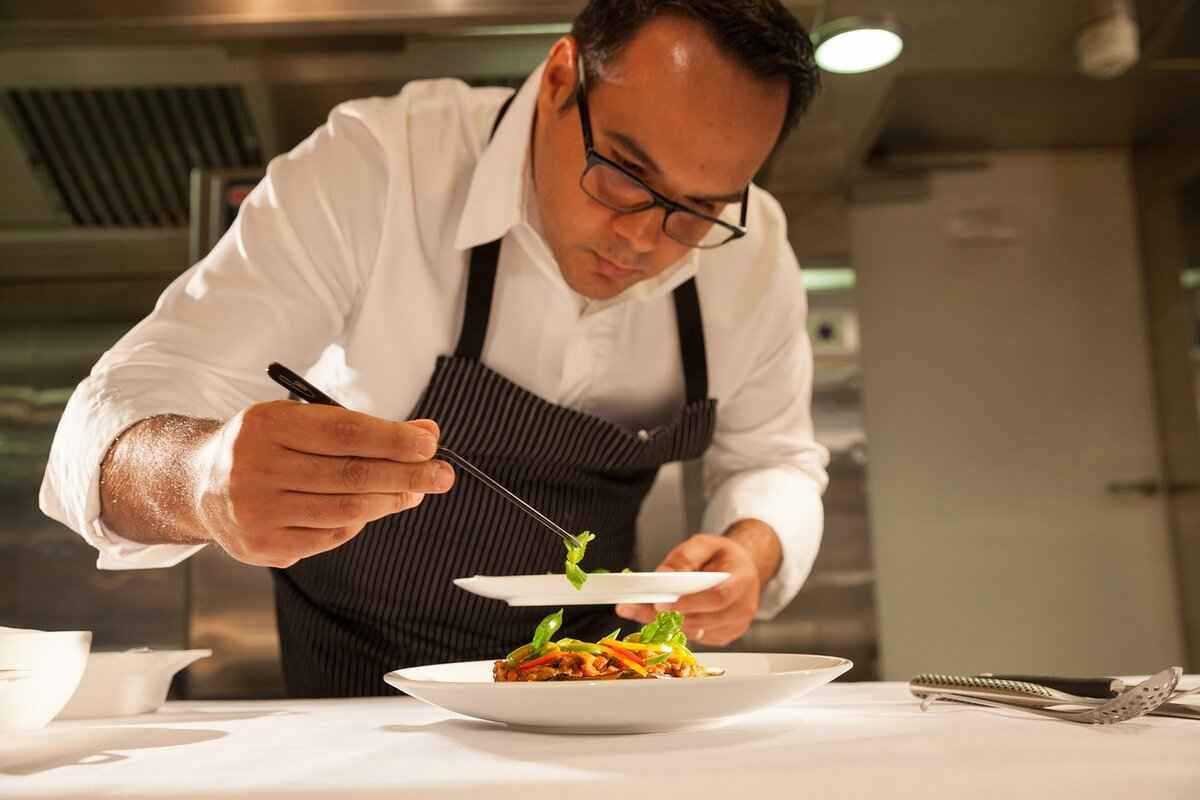This article delves into the fascinating world where fine dining intersects with traditional Asian cuisine. It highlights the innovative techniques, artistic presentation styles, and cultural shifts that are redefining culinary experiences globally.
What is Fine Dining?
Fine dining refers to an upscale dining experience characterized by high-quality ingredients, exceptional service, and an elegant atmosphere. These establishments elevate the dining experience through meticulous attention to detail, ambiance, and a curated menu that often features seasonal and local produce.
How are Traditional Asian Dishes Adapted in Fine Dining?
Fine dining restaurants are creatively adapting traditional Asian dishes by incorporating modern techniques and global flavors. Chefs are reimagining classic recipes to enhance their appeal, making them more palatable to a diverse audience.
- Innovative Cooking Techniques: Chefs are utilizing advanced cooking methods such as sous-vide and molecular gastronomy to elevate traditional Asian dishes. These techniques not only enhance flavor but also improve texture, creating a unique dining experience.
- Fusion of Global Flavors: The fusion of global ingredients with traditional Asian recipes is a key trend in fine dining. Chefs blend flavors to create unique culinary experiences, like incorporating truffle oil into a classic dumpling.
- Artful Presentation: Presentation plays a crucial role in fine dining. Traditional Asian dishes are being presented in visually stunning ways that enhance the dining experience, transforming meals into works of art.
Preserving Authenticity While Innovating
While innovation is vital, preserving the authenticity of traditional dishes is equally important. Chefs strive to achieve a balance between innovation and tradition, ensuring that the essence of the dish remains intact while introducing modern elements.
What Role Does Cultural Context Play?
Cultural context significantly influences how traditional Asian dishes are transformed in fine dining. Understanding the cultural significance of these dishes is essential for chefs, as it informs their adaptation process and enhances the authenticity of their culinary creations.
- Understanding Cultural Significance: Recognizing the cultural significance of traditional dishes is crucial. Chefs who appreciate these aspects can create menus that honor the origins of the cuisine while introducing innovative twists.
- Impact on Culinary Identity: The transformation of traditional Asian dishes in fine dining can impact culinary identity. These changes often reflect broader cultural shifts and globalization, showcasing how cuisine evolves over time.
Why is Fine Dining Popularizing Asian Cuisine?
The rising popularity of fine dining is bringing Asian cuisine to the forefront of the culinary world. Several factors contribute to this trend, including:
- Increased Global Interest: As global interest in Asian cuisine grows, fine dining establishments are embracing these flavors. This trend reshapes culinary landscapes worldwide, introducing more people to the rich diversity of Asian food.
- Celebrity Chefs and Media Influence: The role of celebrity chefs and media in popularizing Asian cuisine cannot be understated. These influencers shape perceptions and trends, making Asian dishes more accessible and appealing to a broader audience.
What is the Future of Fine Dining and Asian Cuisine?
The future of fine dining in relation to Asian cuisine is promising, with ongoing innovations and cultural exchanges. Emerging trends, such as sustainability and plant-based options, are influencing fine dining, and chefs are integrating these concepts into traditional Asian dishes.
- Emerging Trends to Watch: Sustainability is becoming a priority in fine dining. Chefs are sourcing ingredients responsibly and creating dishes that reflect environmental consciousness.
- Global Culinary Collaborations: Collaborations between chefs from different cultures foster innovation. These partnerships create exciting new interpretations of traditional Asian cuisine, leading to a vibrant culinary landscape.

What is Fine Dining?
Fine dining is an exquisite culinary experience that transcends mere eating; it is an art form that combines high-quality ingredients, exceptional service, and an elegant atmosphere. This section will explore the fundamental elements that define fine dining establishments, highlighting their unique characteristics that set them apart from casual dining options.
- Ambiance: The atmosphere in fine dining restaurants is meticulously curated. From the lighting to the decor, every detail is designed to create a sophisticated environment.
- Service: Exceptional service is a hallmark of fine dining. Staff are trained to provide personalized attention, ensuring that every guest feels valued and catered to.
- Menu Quality: The menu features meticulously crafted dishes made from the finest ingredients, often sourced from local farmers or specialty suppliers.
- Presentation: Dishes are presented artistically, transforming food into a visual masterpiece that enhances the overall dining experience.
- Wine Pairing: Fine dining often includes expert wine pairings, enhancing the flavors of the meal and elevating the overall experience.
Fine dining plays a crucial role in the culinary world, serving as a platform for culinary innovation and creativity. It allows chefs to experiment with flavors and techniques, pushing the boundaries of traditional cuisine. This culinary exploration not only elevates the dining experience but also fosters a deeper appreciation for food as an art form.
Fine dining establishments often reflect the cultural influences of their regions. Chefs incorporate local flavors and traditional cooking methods, creating a unique dining experience that tells a story. This cultural integration allows diners to explore diverse culinary landscapes while enjoying the sophistication of fine dining.
What sets fine dining apart from other dining experiences is the attention to detail and the commitment to excellence. Every aspect, from the ambiance to the service, is designed to create a memorable experience. This dedication to quality not only satisfies the palate but also engages the senses, leaving a lasting impression on diners.
- Sustainability: Many fine dining restaurants are adopting sustainable practices, focusing on locally sourced ingredients and environmentally friendly operations.
- Plant-Based Options: The rise of plant-based diets has influenced fine dining menus, with chefs creatively crafting dishes that appeal to a broader audience.
- Technology Integration: The use of technology, such as online reservations and digital menus, is becoming increasingly common in fine dining establishments.
In conclusion, fine dining is more than just a meal; it is a multifaceted experience that engages the senses and elevates the appreciation of culinary artistry. By focusing on quality, service, and cultural influences, fine dining establishments continue to redefine what it means to dine well.

How are Traditional Asian Dishes Adapted in Fine Dining?
Fine dining has become a canvas for chefs to explore and reinterpret traditional Asian dishes through the lens of modern culinary techniques and global influences. This transformation not only enhances the appeal of these dishes but also invites diners to experience familiar flavors in innovative ways. In this section, we will delve into how the fine dining scene is reshaping traditional Asian cuisine.
Fine dining establishments are increasingly showcasing traditional Asian recipes, adapting them with a blend of modern techniques and global flavors. This creative fusion allows chefs to elevate these dishes, making them more appealing to a diverse clientele.
One of the most notable aspects of this transformation is the use of advanced cooking methods. Techniques such as sous-vide and molecular gastronomy are becoming commonplace in fine dining kitchens. For example, chefs may prepare a classic Peking duck using sous-vide to achieve perfect tenderness while maintaining the dish’s traditional flavors. This method not only enhances the texture but also allows chefs to experiment with flavor infusions that would be impossible with conventional cooking methods.
The integration of global ingredients into traditional Asian recipes is another exciting trend. Chefs are blending elements from different cuisines to create unique dishes. For instance, a traditional Thai curry might be enhanced with Italian herbs or served alongside French-style ratatouille. This fusion opens up new flavor profiles, making the dining experience more dynamic and engaging.
In fine dining, presentation is as crucial as taste. Chefs are reimagining the visual aspects of traditional Asian dishes to create stunning plates that delight the eye. A classic sushi roll might be deconstructed and artfully arranged with vibrant sauces and garnishes, transforming a simple dish into a work of art. This emphasis on aesthetics not only enhances the dining experience but also elevates the perception of Asian cuisine in the culinary world.
While innovation is key to the evolution of traditional dishes, preserving their authenticity is equally essential. Chefs strive to maintain the cultural integrity of the dishes they adapt. This balance is often achieved through careful research and respect for the origins of the recipes. For instance, when reinterpreting a Vietnamese pho, a chef may retain the traditional broth while experimenting with the noodles or garnishes, ensuring that the essence of the dish remains intact.
The transformation of traditional Asian dishes in fine dining is heavily influenced by cultural context. Understanding the cultural significance of these dishes is crucial for chefs aiming to innovate responsibly. This section explores how cultural appreciation informs the adaptation process and enhances the dining experience.
Recognizing the cultural significance of traditional dishes is essential for chefs. It informs their approach to adaptation, ensuring that changes honor the dish’s heritage. For example, chefs might incorporate storytelling into their menus, explaining the history behind a dish like kimchi while offering a modern twist.
The transformation of traditional Asian dishes in fine dining reflects broader cultural shifts and globalization. As chefs experiment with these dishes, they contribute to a dynamic culinary identity that evolves while honoring its roots. This evolution not only attracts a global audience but also fosters a deeper appreciation for the richness of Asian cuisine.
The rising popularity of fine dining is shining a spotlight on Asian cuisine, driven by factors such as increased global interest and the influence of celebrity chefs. These elements are reshaping culinary landscapes and making Asian dishes more accessible to a wider audience.
As fine dining continues to evolve, emerging trends such as sustainability and plant-based options are influencing how traditional Asian dishes are prepared and presented. Chefs are increasingly focusing on sourcing local ingredients and reducing waste, which aligns with the growing demand for sustainable dining experiences.
Innovative Cooking Techniques
have become a hallmark of modern culinary artistry, especially within the realm of fine dining. Chefs are increasingly embracing advanced methods such as sous-vide and molecular gastronomy to transform traditional Asian dishes into extraordinary culinary experiences. This innovative approach not only enhances the flavors but also elevates the texture and presentation of these beloved meals.
Sous-vide, a French term meaning “under vacuum,” involves cooking food slowly in a temperature-controlled water bath. This technique allows for precise temperature control, ensuring that proteins are cooked evenly and retain their natural juices. For instance, imagine a traditional Peking duck prepared using sous-vide; the result is a tender, juicy meat with a perfectly crisp skin, showcasing the dish’s flavors in a new light. This method also allows chefs to experiment with infusions, such as adding aromatic herbs directly into the cooking bag, enhancing the dish’s complexity.
Molecular gastronomy, on the other hand, is a fascinating intersection of science and culinary arts. It involves using scientific techniques to create innovative textures and flavors. Chefs might utilize spherification to create flavorful “caviar” from soy sauce that bursts in the mouth, adding a surprising element to a traditional ramen dish. This technique not only surprises diners but also adds a playful touch to the dining experience, encouraging them to engage with their food in a new and exciting way.
These innovative cooking techniques are not merely about novelty; they serve a greater purpose in enhancing the overall dining experience. By reimagining traditional Asian dishes through sous-vide and molecular gastronomy, chefs can highlight the natural flavors of ingredients while introducing a modern twist. This transformation also appeals to a broader audience, drawing in those who may not have previously appreciated these cuisines.
Moreover, the impact of these techniques extends beyond flavor and texture; they also play a crucial role in presentation. Fine dining is as much about the visual experience as it is about taste. Chefs are now able to plate dishes in ways that were previously unimaginable, using gels, foams, and intricate designs that captivate the eye. For example, a classic Thai green curry can be deconstructed and reassembled with vibrant colors and textures, turning a familiar dish into a stunning centerpiece.
As chefs continue to explore the boundaries of culinary innovation, the fusion of traditional Asian dishes with modern cooking techniques is likely to evolve further. This ongoing experimentation not only preserves the essence of these dishes but also allows them to thrive in a contemporary dining landscape. The result is a rich tapestry of flavors and experiences that honor tradition while embracing the future.
In conclusion, the integration of sous-vide and molecular gastronomy into traditional Asian cuisine is revolutionizing the dining experience. These innovative cooking techniques not only enhance flavors and textures but also redefine how we perceive and enjoy our meals. As fine dining continues to evolve, the possibilities for creativity and expression in Asian cuisine are limitless, promising an exciting future for both chefs and diners alike.
Fusion of Global Flavors
The culinary world is undergoing a remarkable transformation, particularly in the realm of fine dining, where the with traditional Asian recipes is emerging as a prominent trend. Chefs are not only reinterpreting classic dishes but are also creating entirely new culinary experiences that delight the senses and challenge conventional norms.
The essence of this fusion lies in the combination of diverse ingredients and cooking techniques from around the world, integrated with the rich heritage of Asian cuisine. This innovative approach allows chefs to craft dishes that are both familiar and exotic, appealing to a broad audience.
Chefs are experimenting with unconventional pairings, such as incorporating Mediterranean spices into traditional Thai curries or using Japanese techniques to prepare Italian pasta dishes. This blending not only enhances the flavor profile but also introduces diners to a novel gastronomic experience.
- Sous-Vide Cooking: This method allows for precise temperature control, resulting in perfectly cooked meats and vegetables that retain their natural flavors.
- Molecular Gastronomy: Techniques such as spherification or foaming can transform familiar Asian sauces into unexpected textures and presentations.
- Spice Infusion: Chefs are infusing oils and broths with spices from various cuisines, creating a depth of flavor that enhances traditional Asian dishes.
In fine dining, presentation is just as crucial as flavor. The visual appeal of a dish can significantly enhance the dining experience. Chefs are using artistic plating techniques to create stunning presentations that reflect the cultural origins of the ingredients while showcasing their innovative twists.
Understanding the cultural significance of both Asian and global cuisines is vital for chefs. This awareness allows them to respect traditional practices while creatively adapting them. For instance, a chef might honor the traditional methods of preparing sushi while introducing ingredients like truffle oil to elevate the dish for a modern palate.
The fusion of global flavors into traditional Asian cuisine offers several benefits:
- Innovation: It encourages culinary creativity, pushing chefs to explore new horizons and challenge themselves.
- Broader Appeal: By blending familiar flavors with traditional dishes, chefs can attract a wider audience, including those who may not typically enjoy Asian cuisine.
- Cultural Exchange: This fusion promotes a greater understanding and appreciation of different culinary traditions, fostering a sense of community and connection among diners.
The future of fine dining and the fusion of global flavors with traditional Asian recipes looks bright. As culinary boundaries continue to blur, chefs will likely explore even more innovative combinations, leading to exciting new dishes that reflect the evolving tastes of a global society.
In conclusion, the fusion of global flavors with traditional Asian recipes is not just a passing trend; it represents a significant shift in the culinary landscape. Through creativity, respect for tradition, and a commitment to excellence, chefs are redefining what fine dining means, offering diners unique and memorable experiences.
Artful Presentation
is a hallmark of fine dining, particularly when it comes to traditional Asian dishes. The way food is plated can significantly enhance the overall dining experience, transforming a meal into a visual feast that captivates the senses. In this section, we will explore how chefs are elevating the presentation of Asian cuisine, making it not just a meal, but an art form.
The importance of presentation in fine dining cannot be overstated. It serves several purposes:
- Visual Appeal: A well-presented dish is more inviting and can stimulate appetite.
- Storytelling: Presentation can convey the cultural background and story behind a dish, adding depth to the dining experience.
- Memorability: Unique presentations create lasting impressions, encouraging diners to return.
Chefs are utilizing various innovative techniques to present traditional Asian dishes in visually stunning ways. Techniques such as:
- Deconstruction: Breaking down a dish into its components and presenting them separately allows diners to appreciate each element.
- Height and Layers: Creating height with ingredients adds drama and sophistication to the plate.
- Color Contrast: Using vibrant ingredients to create a color palette that is visually striking enhances the overall aesthetic.
In fine dining, the presentation of traditional Asian dishes often incorporates elements of cultural significance. For example:
- Traditional Tableware: Using handcrafted plates and bowls can enhance the authenticity of the dining experience.
- Edible Garnishes: Incorporating herbs and flowers that are native to the dish’s origin can provide a fresh touch and enhance flavor.
- Seasonal Themes: Presenting dishes in a way that reflects the seasons or regional festivals can create a deeper connection to the culture.
Artful presentation is not just about aesthetics; it’s also about storytelling. Each dish can tell a story about its origins, ingredients, and the chef’s interpretation. For instance:
- Ingredient Origins: Highlighting local and seasonal ingredients can tell a story of sustainability and freshness.
- Culinary Techniques: Showcasing traditional cooking methods through presentation can honor the dish’s heritage.
- Personal Touch: Chefs often include personal elements in their presentations, reflecting their journey and experiences.
The rise of social media has significantly influenced how dishes are presented in fine dining. Chefs are increasingly aware that their creations will be shared online, leading to:
- More Creative Plating: The desire to create ‘Instagrammable’ dishes encourages chefs to push the boundaries of traditional plating.
- Engagement with Diners: Restaurants often invite feedback on presentation styles, fostering a community of culinary enthusiasts.
- Trend Setting: Viral food trends can inspire chefs to adopt innovative techniques that may not have been considered before.
In summary, the art of presentation in fine dining, particularly with traditional Asian dishes, is a dynamic blend of creativity, culture, and storytelling. As chefs continue to innovate and adapt, the dining experience evolves, captivating not only the palate but also the eyes and hearts of diners.
Preserving Authenticity While Innovating
In the realm of culinary arts, the intersection of innovation and tradition is a delicate balance that many chefs strive to achieve. Particularly within the context of traditional Asian cuisine, this challenge becomes even more pronounced. As chefs experiment with modern techniques and flavors, they must also ensure that the essence of the original dishes is not lost. This section delves into how culinary professionals navigate this intricate landscape, preserving authenticity while embracing innovation.
Preserving the authenticity of traditional dishes is crucial for several reasons. Firstly, these dishes often carry significant cultural heritage, representing the history and identity of a community. For many, traditional recipes are a link to their ancestors and cultural roots. Secondly, the flavors and techniques inherent in these dishes have been refined over generations, providing a depth of taste and experience that can be difficult to replicate. Thus, maintaining authenticity is not merely about following a recipe; it is about honoring a rich tapestry of cultural significance.
Chefs today are increasingly aware of the need to innovate while respecting traditional practices. One way this balance is achieved is through the incorporation of modern cooking techniques such as sous-vide and fermentation. These methods can enhance flavors and textures without altering the core identity of the dish. For instance, a traditional ramen might be served with sous-vide egg, enhancing the experience while maintaining its original essence.
The rise of fusion cuisine has sparked debates about authenticity. While some argue that blending different culinary traditions can lead to exciting new flavors, others contend that it risks diluting the original dish’s cultural significance. Chefs who successfully navigate this challenge often do so by using fusion as a platform for storytelling, where each ingredient choice reflects a journey through different cultures while still honoring the dish’s roots.
Presentation plays a pivotal role in fine dining, especially when it comes to traditional Asian dishes. Chefs are reimagining how these dishes are plated, transforming them into visual masterpieces. This artistic approach not only enhances the dining experience but also invites diners to appreciate the cultural context behind each dish. For example, a simple dumpling can be elevated to a work of art through careful plating techniques, garnishes, and sauces that tell a story of tradition and innovation.
Cultural context is a vital component in the adaptation of traditional dishes. Chefs who understand the cultural significance of the ingredients and techniques they are using are better equipped to innovate respectfully. Engaging with local communities and learning from elders can provide invaluable insights that inform the adaptation process, ensuring that the essence of the dish remains intact.
Community involvement is essential in preserving the authenticity of traditional dishes. By collaborating with local producers and utilizing regional ingredients, chefs can create dishes that reflect both innovation and tradition. This not only supports local economies but also fosters a deeper connection between the chef and the cultural roots of the cuisine they are presenting.
As the culinary landscape continues to evolve, we can anticipate a growing emphasis on sustainability and ethical sourcing in fine dining. Chefs will increasingly focus on using locally sourced ingredients that honor traditional practices while embracing modern techniques. This trend aligns with the broader movement towards environmentally conscious dining, ensuring that the future of fine dining respects both the planet and cultural heritage.

What Role Does Cultural Context Play?
Cultural context plays a pivotal role in the transformation of traditional Asian dishes within the realm of fine dining. As culinary innovation continues to evolve, understanding the cultural significance of these dishes is essential for chefs and restaurateurs alike. This section delves into the intricate relationship between culture and cuisine, highlighting how appreciation and understanding can lead to innovative yet respectful adaptations of traditional recipes.
In the world of fine dining, cultural appreciation goes beyond mere aesthetics; it involves a deep understanding of the history, traditions, and values associated with traditional Asian cuisine. Chefs who take the time to learn about the origins of the dishes they are reinterpreting are better equipped to honor their cultural significance while incorporating modern techniques and flavors.
- Research and Education: Many chefs engage in extensive research, studying the cultural contexts of the dishes they wish to adapt. This can involve reading literature, attending cultural festivals, or even traveling to the regions where these cuisines originate.
- Collaboration with Cultural Experts: Working alongside cultural consultants or chefs from the originating culture can provide invaluable insights that enhance authenticity. This collaboration ensures that adaptations do not stray too far from their roots.
- Community Engagement: Engaging with local communities helps chefs understand how traditional dishes are consumed and celebrated, allowing for a more respectful approach to innovation.
The transformation of traditional Asian dishes in fine dining not only reflects individual chef’s creativity but also influences broader culinary identities. As chefs innovate, they often blend elements from various cultures, leading to a fusion that may redefine what constitutes traditional cuisine.
This fusion can sometimes lead to a cultural dilution, where the original essence of the dish is lost. However, when approached thoughtfully, it can celebrate and elevate the culinary identity of the culture in question. Chefs who respect the origins of their ingredients and techniques contribute to a richer, more diverse culinary landscape.
Globalization has significantly impacted how traditional Asian dishes are perceived and transformed in fine dining. As Asian cuisine gains popularity worldwide, chefs are increasingly experimenting with these dishes, often incorporating local ingredients and techniques. This can lead to exciting new interpretations but also raises questions about authenticity and cultural appropriation.
To navigate these challenges, chefs must balance innovation with respect for tradition, ensuring that their adaptations honor the cultural significance of the original dishes. By doing so, they contribute to a culinary dialogue that celebrates diversity and fosters understanding.
Understanding cultural context enriches the dining experience for patrons. When diners are aware of the stories and traditions behind the dishes they are enjoying, it fosters a deeper connection to the food. This connection can enhance their appreciation of the meal, transforming it from mere sustenance into a cultural experience.
Moreover, fine dining establishments that emphasize cultural context often attract a clientele eager to explore new culinary horizons. These diners are not just looking for a meal; they seek an experience that connects them to the rich tapestry of global cultures.
In conclusion, the role of cultural context in the transformation of traditional Asian dishes in fine dining cannot be overstated. By embracing cultural appreciation and understanding, chefs can create innovative dishes that honor their origins while providing unique culinary experiences. This careful balance between tradition and innovation is essential for the continued evolution of Asian cuisine in the fine dining landscape.
Understanding Cultural Significance
Understanding the cultural significance of traditional dishes is crucial for chefs aiming to create meaningful culinary experiences. In the realm of fine dining, this understanding informs not only the adaptation of recipes but also the overall dining experience. Chefs who appreciate the historical and cultural contexts of the dishes they serve can create a deeper connection with their guests.
Many traditional Asian dishes are steeped in cultural history and are often tied to specific rituals, festivals, or family gatherings. For instance, dishes like dumplings in China symbolize wealth and prosperity, especially during the Lunar New Year. Recognizing these cultural ties allows chefs to honor the origins of the dishes while also presenting them in a modern context.
When chefs adapt traditional dishes for fine dining, they often incorporate innovative techniques and contemporary flavors. However, it is essential that they do so with a sense of respect for the dish’s roots. This balance is achieved by understanding the ingredients, cooking methods, and cultural narratives that define these dishes. For example, while a chef may use molecular gastronomy to create a deconstructed version of a traditional dish, they should still incorporate authentic flavors and textures to maintain its essence.
Moreover, cultural insights can guide chefs in their choice of presentation and service styles. Fine dining is not just about the food; it’s also about the overall experience. By incorporating elements such as traditional serving ware or culturally significant garnishes, chefs can enhance the storytelling aspect of each dish. This approach not only elevates the dining experience but also educates diners about the cultural significance behind each plate.
Furthermore, chefs who engage with local communities and learn from cultural custodians can gain invaluable insights. This engagement fosters a mutual respect and understanding that enriches the culinary landscape. For instance, collaborating with local artisans or farmers can provide chefs with unique ingredients that are not only authentic but also reflect the region’s heritage.
- Respect for Tradition: Chefs must honor the original flavors and ingredients while innovating.
- Community Engagement: Learning from local cultures enhances authenticity.
- Storytelling Through Food: Each dish should narrate its cultural significance.
In conclusion, recognizing the cultural significance of traditional dishes is not just a matter of culinary technique; it is an essential component of creating a holistic fine dining experience. Chefs who embrace this understanding can transform traditional Asian dishes into modern masterpieces that resonate with diners on multiple levels. By weaving cultural narratives into their culinary creations, chefs not only elevate their dishes but also contribute to a broader appreciation of the rich tapestry of global cuisine.
Impact on Culinary Identity
The culinary landscape is in constant evolution, and the impact of fine dining on traditional Asian dishes is a significant aspect of this transformation. As chefs experiment with innovative techniques and presentation styles, they are not only redefining these dishes but also influencing the broader culinary identity associated with Asian cuisine. This section delves into how these changes reflect wider cultural shifts and the forces of globalization.
At the heart of culinary identity lies the essence of tradition, culture, and regional flavors. When traditional Asian dishes undergo transformation in fine dining settings, they often reflect a blend of heritage and modernity. This blending can lead to a re-evaluation of what constitutes “authentic” cuisine. The question arises: How do these transformations influence the perception of culinary identity?
Globalization has played a pivotal role in altering culinary identities. As chefs gain access to international ingredients and techniques, they are inspired to create dishes that cross cultural boundaries. This fusion not only introduces new flavors but also invites diners to experience a global palette through the lens of traditional Asian cuisine. The result is a culinary identity that becomes more inclusive and diverse.
While innovation is essential for the growth of fine dining, preserving the authenticity of traditional Asian dishes remains crucial. Chefs often strive to maintain the soul of these dishes while incorporating modern elements. This balance is vital in ensuring that the cultural significance of the food is not lost. How can chefs achieve this delicate equilibrium?
Understanding the cultural significance of traditional dishes is essential for chefs who wish to innovate responsibly. By acknowledging the history and meaning behind these recipes, chefs can create adaptations that respect their origins while appealing to contemporary tastes. This cultural appreciation fosters a deeper connection between the diner and the dish, enhancing the overall experience.
The transformation of traditional Asian dishes in fine dining presents a dual perspective on culinary identity. On one hand, it allows for the celebration of innovation and creativity, showcasing the versatility of these dishes. On the other hand, it risks alienating traditionalists who may view these adaptations as a dilution of cultural heritage. This dynamic tension is crucial in understanding the evolving nature of culinary identity.
As fine dining continues to evolve, the impact on culinary identity will likely resonate with future generations. Young chefs are increasingly embracing both tradition and innovation, leading to a new wave of culinary exploration. This trend raises questions about the future of Asian cuisine: Will future chefs prioritize tradition, or will they lean more towards innovation?
The intersection of fine dining and traditional Asian cuisine is a fascinating area of study that reveals much about cultural shifts and globalization. As chefs navigate the complexities of innovation and authenticity, they play a crucial role in shaping culinary identity. The ongoing dialogue between tradition and modernity promises to enrich the culinary landscape, ensuring that traditional Asian dishes remain relevant and celebrated in fine dining contexts.

Why is Fine Dining Popularizing Asian Cuisine?
The culinary landscape is undergoing a significant transformation, and at the heart of this evolution is the rising popularity of fine dining, which is increasingly spotlighting Asian cuisine. As diners seek unique and memorable experiences, fine dining establishments are adapting traditional Asian dishes, bringing them to the forefront of the culinary world. This article delves into the factors contributing to this trend and its implications for the future.
Several key factors are fueling the growing interest in Asian cuisine within fine dining. Understanding these elements is essential for grasping the broader culinary trends.
- Increased Global Interest: There has been a noticeable rise in global interest in Asian flavors, driven by increased travel and cultural exchange. Diners are now more familiar with diverse Asian dishes and are eager to explore them in a fine dining context.
- Celebrity Chefs and Media Influence: Renowned chefs are embracing Asian cuisine, showcasing it through popular television shows and social media platforms. Their influence helps demystify traditional dishes, making them more accessible and appealing to a wider audience.
- Health Consciousness: Many Asian dishes are inherently healthy, featuring fresh vegetables, lean proteins, and aromatic spices. This aligns well with the modern consumer’s focus on health and wellness, making Asian cuisine a popular choice in fine dining settings.
Fine dining restaurants are not merely serving traditional dishes; they are reimagining them. This innovation is evident in several areas:
- Creative Adaptation: Chefs are creatively adapting classic recipes, incorporating modern techniques such as sous-vide and molecular gastronomy. This not only enhances flavors but also transforms the dining experience.
- Artful Presentation: The visual aspect of food has become paramount in fine dining. Chefs are presenting traditional Asian dishes in visually stunning ways, often using unique plating techniques that elevate the overall dining experience.
- Ingredient Fusion: The fusion of global ingredients with traditional Asian recipes is a hallmark of fine dining innovation. Chefs are blending flavors and textures, creating unique dishes that surprise and delight diners.
Understanding the cultural significance of Asian cuisine is crucial for appreciating its rise in fine dining. Chefs who respect and acknowledge the origins of the dishes they serve contribute to a richer dining experience.
- Cultural Appreciation: Chefs and diners alike are recognizing the importance of cultural appreciation. This understanding fosters respect for the traditions and histories behind the dishes, enhancing the overall culinary experience.
- Impact on Culinary Identity: The transformation of traditional Asian dishes in fine dining reflects broader cultural shifts and globalization. As these dishes gain prominence, they influence culinary identities, reshaping perceptions of Asian cuisine.
The future of Asian cuisine in fine dining appears bright, with ongoing innovations and cultural exchanges paving the way for exciting developments. Emerging trends, such as sustainability and plant-based options, are likely to further influence how traditional dishes are reinterpreted.
- Emerging Trends: Sustainability is becoming a key focus in fine dining, prompting chefs to source local and organic ingredients. This trend is particularly relevant for Asian cuisine, which often emphasizes fresh, seasonal produce.
- Global Culinary Collaborations: Collaborations between chefs from different culinary backgrounds are fostering innovation. These partnerships lead to the creation of exciting new interpretations of traditional Asian dishes, further enriching the fine dining experience.
In summary, the rising popularity of fine dining is significantly impacting the perception and presentation of Asian cuisine. As chefs continue to innovate while respecting traditional roots, diners can expect to enjoy a rich tapestry of flavors and experiences that celebrate the best of both worlds.
Increased Global Interest
As the world becomes increasingly interconnected, the culinary scene is undergoing a remarkable transformation, particularly in the realm of Asian cuisine. The in these vibrant flavors is not just a passing trend; it is reshaping the culinary landscape in profound ways. This article delves into the factors driving this phenomenon and its implications for fine dining establishments worldwide.
Several key factors contribute to the rising popularity of Asian cuisine:
- Cultural Exchange: As travel becomes more accessible, people are exposed to various cuisines, leading to a greater appreciation for Asian flavors.
- Health Consciousness: Many Asian dishes emphasize fresh ingredients and balanced flavors, appealing to health-conscious diners.
- Social Media Influence: Platforms like Instagram and TikTok showcase visually appealing dishes, sparking curiosity and interest among food enthusiasts.
Fine dining restaurants are increasingly incorporating Asian flavors into their menus, employing innovative techniques and presentation styles. This adaptation is evident in:
- Creative Fusion: Chefs are blending traditional Asian recipes with Western culinary techniques, resulting in unique dishes that surprise and delight patrons.
- Artful Presentation: The aesthetic appeal of food is paramount in fine dining. Asian dishes are often presented with intricate designs, enhancing the overall dining experience.
- Ingredient Exploration: Fine dining chefs are sourcing authentic ingredients from Asia, ensuring that their dishes retain the integrity of traditional recipes while adding a modern twist.
Celebrity chefs and media personalities have played a significant role in elevating Asian cuisine within the fine dining sector. Their influence can be seen in:
- Television Shows: Cooking shows featuring Asian cuisine have introduced viewers to the intricacies of these dishes, making them more accessible.
- Cookbooks and Blogs: Renowned chefs often publish cookbooks that highlight Asian recipes, encouraging home cooks to experiment with these flavors.
- Social Media Presence: Celebrity chefs leverage social media to showcase their culinary creations, further popularizing Asian cuisine among a broader audience.
Globalization has led to a fascinating interplay between tradition and innovation in Asian cuisine. Chefs are tasked with the challenge of preserving authenticity while embracing modern culinary trends. This balance is crucial for maintaining the cultural significance of these dishes. Some key points include:
- Adapting to Local Tastes: Chefs often modify traditional recipes to cater to local preferences without compromising their essence.
- Collaborative Efforts: Many fine dining establishments are collaborating with Asian chefs to ensure that the cultural nuances of the cuisine are respected and represented accurately.
- Educational Initiatives: Some restaurants offer workshops and tastings to educate diners about the history and significance of Asian dishes, fostering a deeper appreciation.
The future of Asian cuisine within the fine dining sector looks promising, with ongoing innovations and cultural exchanges paving the way for exciting developments. As chefs continue to experiment with flavors and techniques, Asian cuisine is poised to remain a staple in the global culinary landscape. The fusion of traditional and modern elements will likely lead to even more creative interpretations, ensuring that this vibrant cuisine continues to thrive.
Celebrity Chefs and Media Influence
The culinary world has undergone a significant transformation in recent years, with celebrity chefs and media playing pivotal roles in popularizing Asian cuisine. This section delves into how these influential figures are reshaping perceptions and trends in fine dining.
Celebrity chefs have become the face of modern culinary culture, often acting as ambassadors for various cuisines. Their ability to showcase Asian cuisine through television shows, cookbooks, and social media platforms has dramatically increased its visibility. They introduce traditional dishes to a broader audience, often infusing them with contemporary twists that resonate with modern diners.
Media outlets, including food blogs, television programs, and social media, serve as powerful platforms that spotlight Asian cuisine. Shows like Top Chef and MasterChef often feature Asian-inspired challenges, exposing viewers to the intricate flavors and techniques of this rich culinary tradition. Furthermore, social media influencers create visually appealing content that captures the essence of these dishes, making them highly shareable and desirable.
Many celebrity chefs are not just promoting Asian cuisine; they are reinventing it. By incorporating global ingredients and modern cooking techniques, they are creating new interpretations of classic dishes. For example, a traditional ramen might be elevated with gourmet truffles or unique spices, appealing to fine dining enthusiasts while maintaining its cultural roots.
While innovation is essential, maintaining cultural authenticity is equally crucial. Chefs strive to respect the origins of the dishes they adapt, ensuring that the essence of the cuisine is preserved. This balance between innovation and authenticity is vital for fostering genuine appreciation among diners.
The presence of celebrity chefs in the media significantly impacts public perception of Asian cuisine. Their endorsements can transform a dish from being perceived as exotic to a must-try culinary experience. This shift in perception encourages diners to explore and embrace the diversity of flavors offered by Asian cuisine.
The influence of celebrity chefs and media on Asian cuisine has profound implications for the fine dining industry. As more restaurants incorporate Asian flavors into their menus, diners are increasingly seeking out these experiences. This trend not only elevates Asian cuisine within the fine dining sector but also fosters a greater understanding and appreciation of its cultural significance.
Social media platforms like Instagram and TikTok have revolutionized how food is showcased and consumed. Dishes that are visually stunning often go viral, leading to increased interest in specific cuisines. As chefs share their culinary creations online, they inspire a new generation of food enthusiasts to explore the rich tapestry of Asian flavors.
The future of Asian cuisine in fine dining looks promising, with ongoing innovation and cultural exchange. As chefs continue to collaborate and experiment, we can expect to see even more exciting interpretations of traditional dishes. This evolution is likely to foster a deeper appreciation for the intricate flavors and cultural stories behind Asian cuisine.

What is the Future of Fine Dining and Asian Cuisine?
The culinary world is witnessing a remarkable transformation, particularly in the realm of fine dining and Asian cuisine. As chefs and restaurateurs embrace innovation, the future of this culinary landscape appears to be vibrant and full of potential. The intersection of traditional Asian flavors with modern techniques and global influences is reshaping the dining experience.
The future of fine dining in relation to Asian cuisine is not just promising; it is a canvas of ongoing innovation and dynamic cultural exchanges. As the culinary world evolves, several trends are emerging that will define the future of fine dining, particularly in how Asian cuisine is presented and perceived.
One of the most significant trends is the increasing focus on sustainability. Fine dining establishments are prioritizing locally sourced ingredients and eco-friendly practices. This shift not only enhances the quality of dishes but also resonates with the growing consumer demand for responsible dining.
- Plant-Based Options: The rise of plant-based diets is influencing chefs to adapt traditional Asian dishes. Ingredients like tofu, tempeh, and a variety of vegetables are being used creatively to offer delicious, sustainable options.
- Seasonal Menus: Many fine dining restaurants are now offering seasonal menus that highlight the best of local produce, aligning with the principles of sustainability and freshness.
Another exciting aspect of the future of fine dining is the collaboration between chefs from different cultural backgrounds. These partnerships foster creativity and lead to the emergence of fusion cuisine, where traditional Asian dishes are reimagined with global influences.
| Collaboration Examples | Resulting Dishes |
|---|---|
| Japanese-French | Sushi with truffle oil |
| Thai-Italian | Pasta with green curry sauce |
| Indian-Mexican | Tacos with tandoori chicken |
Technology is playing a crucial role in the evolution of fine dining. From online reservations to digital menus, technology enhances the customer experience. Moreover, chefs are utilizing advanced cooking techniques such as molecular gastronomy and sous-vide cooking to elevate traditional Asian dishes, creating unique flavors and textures.
Cultural exchange is vital in shaping the future of fine dining. As chefs travel and explore different culinary traditions, they bring back new ideas that enrich their own cooking. This exchange allows for a deeper understanding and appreciation of traditional Asian cuisine, leading to innovations that respect and celebrate its roots.
Looking ahead, the future of fine dining in relation to Asian cuisine promises a blend of tradition and innovation. As chefs continue to experiment with flavors and techniques, diners can expect a more immersive and engaging culinary experience. The integration of sustainability, technology, and cultural collaboration will not only redefine fine dining but also elevate Asian cuisine to new heights on the global stage.
Emerging Trends to Watch
Emerging trends in the culinary world are reshaping the landscape of fine dining, particularly in how traditional Asian dishes are being presented and enjoyed. One of the most significant shifts is the growing emphasis on sustainability and plant-based options. These trends are not just fleeting; they represent a fundamental change in consumer preferences and culinary practices.
Fine dining establishments are increasingly adopting sustainable practices in their operations. This includes sourcing ingredients locally, reducing food waste, and opting for organic produce. Chefs are now more aware of the environmental impact of their choices, leading to a more conscientious approach to traditional Asian recipes. For instance, many restaurants are replacing meat with plant-based alternatives, allowing them to create dishes that are not only delicious but also eco-friendly.
The rise of plant-based diets has prompted chefs to innovate traditional Asian cuisine. Dishes that once relied heavily on meat are now being reimagined using vegetables, legumes, and grains. For example, a classic Pad Thai can be transformed into a vibrant dish featuring tofu, bean sprouts, and a medley of colorful vegetables, offering a fresh take on a beloved favorite.
Fine dining chefs are also experimenting with global ingredients to enhance traditional Asian dishes. By incorporating elements from other cuisines, they create unique flavor profiles that appeal to a broader audience. For instance, adding quinoa to a traditional Japanese sushi roll not only boosts its nutritional value but also introduces a modern twist that excites diners.
In fine dining, presentation is paramount. Chefs are focusing on how traditional Asian dishes are plated, using techniques that elevate their visual appeal. This artistic approach not only enhances the dining experience but also respects the cultural significance of the dishes. A beautifully plated dim sum or a meticulously arranged pho can transform a simple meal into a culinary masterpiece.
While innovation is essential, maintaining the authenticity of traditional dishes is equally important. Chefs strive to respect the origins of the recipes while introducing modern elements. This balance ensures that diners can enjoy the rich cultural heritage of Asian cuisine alongside contemporary culinary trends.
The future of fine dining in relation to Asian cuisine looks promising. With the ongoing incorporation of sustainability and plant-based options, traditional dishes are expected to evolve further. As chefs continue to experiment and innovate, we can anticipate a culinary landscape that honors tradition while embracing modernity.
As emerging trends like sustainability and plant-based diets gain traction, they are reshaping the fine dining experience, particularly in the realm of traditional Asian cuisine. By integrating these trends, chefs are not only enhancing the flavors and presentation of their dishes but also promoting a more sustainable and health-conscious dining culture.
Global Culinary Collaborations
In recent years, the culinary world has witnessed a remarkable trend: collaborations between chefs from diverse cultural backgrounds. These partnerships are not only enriching the culinary landscape but also fostering innovation in traditional Asian cuisine. This section delves into how these unique collaborations are reshaping the way we perceive and enjoy Asian dishes.
When chefs from various cultures come together, they bring their unique perspectives, techniques, and flavors to the table. This fusion can lead to the creation of exciting new interpretations of traditional Asian dishes. For instance, a Japanese chef collaborating with a French pastry chef might reimagine a classic mochi dessert by incorporating elements of pâtisserie, resulting in a delightful blend of textures and flavors.
- Asian-Fusion Pop-Ups: Many cities now host pop-up events where chefs from different backgrounds collaborate to create limited-time menus that celebrate both cultures.
- Celebrity Chef Collaborations: Renowned chefs often team up for special events, showcasing their unique styles and creating dishes that highlight the best of both worlds.
- Collaborative Cookbooks: Chefs are publishing cookbooks that feature recipes born from their collaborations, offering readers a chance to recreate these innovative dishes at home.
Beyond the culinary innovations, these collaborations serve as a platform for cultural exchange. When chefs share their culinary heritage, they foster a deeper appreciation for the traditions behind each dish. This cultural understanding is crucial in maintaining authenticity while embracing innovation.
Dining experiences are being transformed through these collaborations. Restaurants that embrace this trend often feature tasting menus that showcase the collaborative efforts of chefs, allowing diners to experience a journey through different cultures in a single meal. This not only enhances the dining experience but also encourages guests to explore and appreciate diverse culinary traditions.
One of the challenges chefs face in these collaborations is striking the right balance between preserving traditional flavors and introducing modern techniques. Many chefs approach this by carefully selecting which elements of a dish to innovate while keeping the essence of the original recipe intact. For example, a traditional Thai curry might be presented in a deconstructed format, allowing diners to appreciate each component while enjoying a familiar flavor profile.
The future of culinary collaborations looks promising as more chefs recognize the value of sharing their culinary heritage. As global trends continue to evolve, we can expect to see even more innovative dishes that push the boundaries of traditional Asian cuisine. Chefs will likely continue to experiment with local ingredients and techniques from their own cultures, leading to exciting new culinary landscapes.
In conclusion, are not just a trend; they are a reflection of our increasingly interconnected world. As chefs from different backgrounds unite to create innovative interpretations of traditional Asian cuisine, they are paving the way for a richer, more diverse culinary future. This collaborative spirit not only enhances our dining experiences but also promotes a greater understanding and appreciation of the cultural significance behind each dish.
Frequently Asked Questions
- What is fine dining?
Fine dining is all about creating a sophisticated atmosphere where high-quality ingredients meet exceptional service. Think of it as a culinary experience where every detail counts, from the ambiance to the presentation of the dishes.
- How are traditional Asian dishes adapted in fine dining?
Chefs are getting super creative! They blend modern cooking techniques with classic Asian recipes, adding global flavors to make these dishes even more exciting. It’s like giving a beloved classic a stylish makeover!
- What innovative techniques are used in fine dining?
Advanced methods like sous-vide and molecular gastronomy are game-changers. These techniques not only enhance flavors but also transform textures, making traditional dishes feel fresh and new.
- Why is there a surge in the popularity of Asian cuisine in fine dining?
The global appetite for Asian flavors is skyrocketing! With celebrity chefs showcasing these cuisines and media spotlighting them, fine dining restaurants are eager to embrace the rich tapestry of Asian culinary traditions.
- What does the future hold for fine dining and Asian cuisine?
The future looks bright! With trends like sustainability and plant-based options on the rise, chefs are continuously innovating while respecting the authenticity of traditional dishes. Expect exciting collaborations and new interpretations to emerge!














